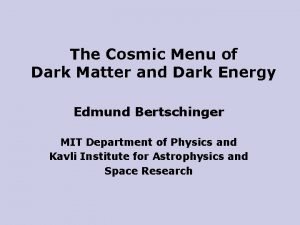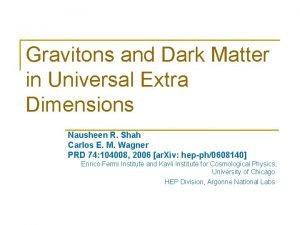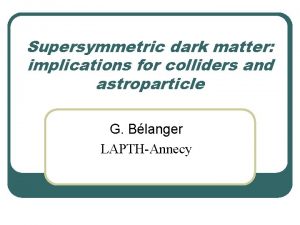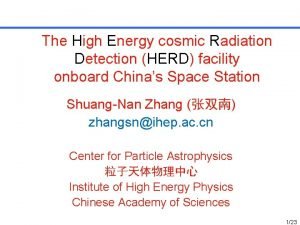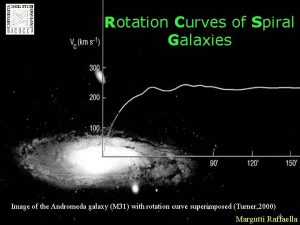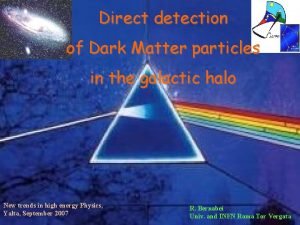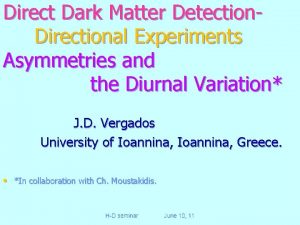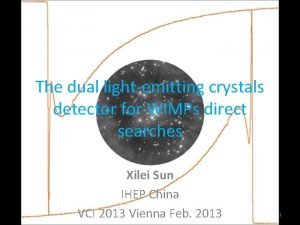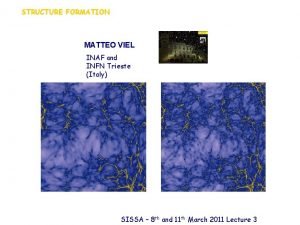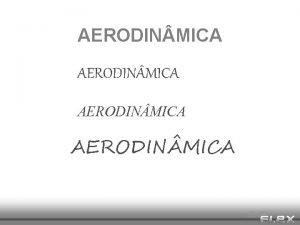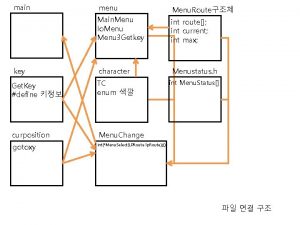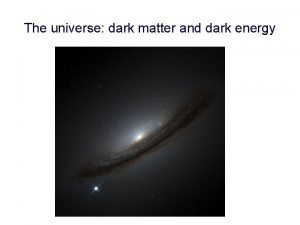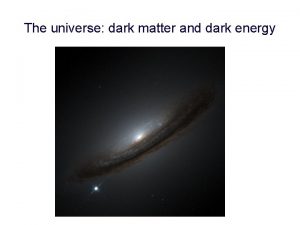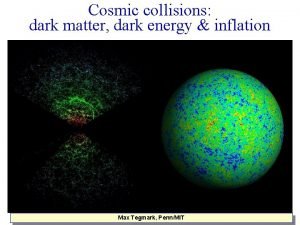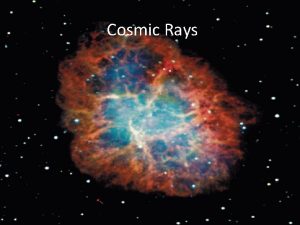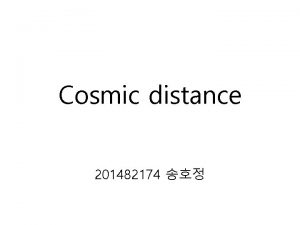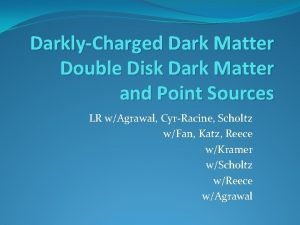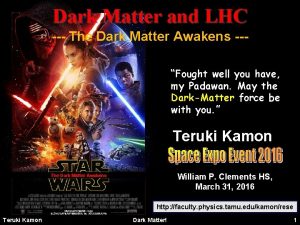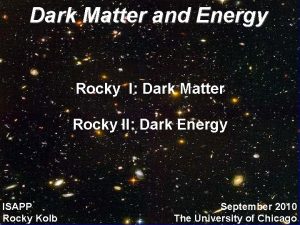The Cosmic Menu of Dark Matter and Dark

















- Slides: 17

The Cosmic Menu of Dark Matter and Dark Energy Edmund Bertschinger MIT Department of Physics and Kavli Institute for Astrophysics and Space Research

Contents of the Universe Today Credit: NASA/ GSFC 2

Observations of the Early Universe: Fossil Relics n Galaxies n Cosmic Microwave Background Radiation n Atoms, Dark Matter and Dark Energy 3

The Most Distant Galaxies Observed with Hubble animations 4

Cosmic Microwave Background Radiation Discovery 1965 Penzias & Wilson AT&T Bell Labs 1978 Nobel Prize 2003: Wilkinson Microwave Anisotropy Probe (WMAP) 5

A Cosmic Sonogram n n n The Big Bang began with a burst of nearexponential expansion: cosmic inflation Quantum mechanical fluctuations in energy made ripples in the gas Animation Fluctuations in radiation == Sound waves! ¨ n Light as sound? ! Yes! Cosmic redshift: Doppler shift in an expanding universe 6

Dark Matter and Dark Energy n Dark Matter: Invisible stuff that gravity draws into galaxies. Crucial element of galaxy formation. n Dark Energy: Invisible stuff that gravity does not draw into galaxies. Instead, this substance accelerates the recent expansion of the Universe. n To date the sole evidence for these substances comes from astrophysics. Despite their similar names, they probably are completely unrelated. 7

Dark Matter Exists around Galaxies GM(r)=r. Vc 2(r) Dark matter Credits: Although diffuse, dark matter is crucial for galaxy formation Left: J. Kormendy (NGC 4216). Right: K. Begeman (NGC 3198) and K. Freeman 8

How did Galaxies Form? n Seed Fluctuations from Early Universe Inflationary epoch: 10 -35 s after Big Bang ¨ Two outcomes: large flat universe, quantum fluctuations ¨ n n Gravitational Amplification Dark Matter Inferred for 50 years, not yet detected on earth ¨ Crucial for galaxy formation! ¨ n Atomic matter ¨ Only 5% of the mass-energy in the Universe, but all that we directly see! 9

Matthias Steinmetz 10

What is the Dark Matter? n n n Elementary particles with low thermal speed, otherwise could not seed galaxy formation Not atomic matter (primordial nucleosynthesis) or neutrinos (too light, too hot) Consensus view: Cold, very weakly interacting particles ¨A new heavy spin-1/2 particle (“neutralino”)? ¨ Large Hadron Collider, 2007 -8 ¨ A new ultralight spin-0 field (“axion”)? ¨ Searches are underway! 11

Dark Matter and Dark Energy n Dark Matter: Invisible stuff that gravity draws into galaxies. Crucial element of galaxy formation. n Dark Energy: Invisible stuff that gravity does not draw into galaxies. Instead, this substance accelerates the recent expansion of the Universe. n To date the sole evidence for these substances comes from astrophysics. Despite their similar names, they probably are completely unrelated. 12

Dark Energy Drives Galaxies Apart Kinetic Energy + Gravitational Energy = Constant R(t) m For sphere of radius R(t), v(t) = d. R/dt, M(t) or Dark Energy dilutes little or not at all as it expands! v increases as R and t increase, acceleration! 13

Acceleration Science Breakthrough of 1998: Deceleration Dark Energy Acceleration Deceleration m-M = log(Distance) z = Redshift = Velocity Credit: High-z Supernova Team 14

What is the dark energy? n A new fundamental field in the universe? ¨ n “Quintessence” – particles whose de Broglie wavelength is billions of light years! A cosmological constant? Proposed by Einstein in 1917 ¨ Retracted as his “greatest blunder” ¨ Energy density of empty space! ¨ n Maybe General Relativity is wrong? ¨ String theory might change gravity across the observable universe 15

We don’t know what the dark energy is! But we want to find out! n n n Why is the energy density of the vacuum so small, when virtual particles should make it huge? If not Huge, why not Zero? Why is dark energy comparably abundant to matter today, when it was negligible 10 billion years ago? Why now? What is the ultimate fate of our Universe? 16

Additional Credits and Information Credits: Hubble Deep Field photo courtesy Space Telescope Science Institute WMAP (Wilkinson Microwave Anisotropy Probe) images courtesy NASA/Goddard Space Flight Center Numerical simulation of galaxy formation (gas and dark matter) courtesy Mattias Steinmetz Books: Origins: Fourteen Billion Years of Cosmic Evolution, Neil de. Grasse Tyson and Donald Goldsmith Just Six Numbers: The Deep Forces that Shape the Universe, Martin J. Rees An Introduction to Modern Cosmology, Andrew Liddle (advanced undergraduate textbook) 17
 Dark matter and dark energy ppt
Dark matter and dark energy ppt Cosmic menu
Cosmic menu White matter of brain
White matter of brain Label the cranial dura septa and associated sinuses.
Label the cranial dura septa and associated sinuses. Gray matter and white matter
Gray matter and white matter What is grey and white matter
What is grey and white matter Cyclical menu
Cyclical menu In a dark dark town
In a dark dark town Dark gravitons other dimensions
Dark gravitons other dimensions Boosted dark matter
Boosted dark matter Dark matter
Dark matter Dark matter pwo
Dark matter pwo Dark matter physics
Dark matter physics Where to stream dark matter
Where to stream dark matter What could dark matter be
What could dark matter be Dark matter
Dark matter Dark matter
Dark matter Dark matter
Dark matter

